How to Train Clients With Rheumatoid Arthritis (Step-by-Step Guide)
Learn how to train clients with rheumatoid arthritis with this guide designed just for personal trainers. Training clients with rheumatoid arthritis can open up a new client base for a personal trainer. But, it’s important that you have the proper tools to train someone with rheumatoid arthritis effectively. Using certain personal training software features can help you train clients with rheumatoid arthritis. Find out how to train clients with rheumatoid arthritis and learn about what tools you’ll need to train someone with rheumatoid arthritis in this guide by Exercise.com
As a fitness professional, you may encounter clients with varying health conditions, one of which could be Rheumatoid Arthritis (RA). This chronic, autoimmune disorder characterized by painful, inflamed joints, can significantly affect a person’s ability to perform regular physical activities. However, with appropriate training and understanding, exercise can play a crucial role in managing RA symptoms and improving overall well-being.
This guide provides comprehensive insights on how to effectively train clients with Rheumatoid Arthritis, discussing suitable exercises, important precautions, and ways to customize fitness programs that accommodate their unique needs while promoting optimal health. It’s all about blending empathy, knowledge, and skill to help your clients navigate their fitness journey despite their health challenges.
- Training someone with rheumatoid arthritis requires careful planning and understanding of their limitations and joint pain.
- Clients with rheumatoid arthritis should avoid exercises with a lot of impact, twisting, or at too high of an intensity.
- Customizable workout software and resources can help improve results for clients with rheumatoid arthritis while maximizing safety.
Breaking into training special populations, like training clients with rheumatoid arthritis, can be a rewarding way for personal trainers to add a new stream of revenue to their fitness businesses.
To train clients with rheumatoid arthritis, it’s important that you’re not only well-versed in rheumatoid arthritis, but that you have the tools in place to make your training as effective as possible; that’s where personal training software comes into play.

By taking advantage of the features that the best personal training software has to offer, you can train clients with rheumatoid arthritis in a way that works for them, not against them.
To learn more about the Exercise.com personal training software platform, book a demo today!
How to Train Clients With Rheumatoid Arthritis
To learn how to train clients with rheumatoid arthritis, it’s imperative that you have a thorough understanding of rheumatoid arthritis and why it’s important to follow certain procedures with these clients.
What is Rheumatoid Arthritis?
Rheumatoid arthritis (RA) is considered inflammation of joints caused by an autoimmune disorder. According to the American College of Sports Medicine (ACSM), rheumatoid arthritis may have inflammatory agents over 100 times that of healthy adults.
Rheumatoid and osteoarthritis aren’t identical, but they do present similar symptoms. Both versions of arthritis cause notable joint pain due to the degeneration of the connective tissues surrounding joints. This can make it very challenging for clients to perform normal exercise routines.
Rheumatoid arthritis (RA) is a chronic autoimmune disease that affects the joints, causing pain, stiffness, swelling, and reduced range of motion. As a fitness professional, it is important to understand this condition thoroughly in order to effectively train clients with rheumatoid arthritis. This article will provide a comprehensive guide on how to train clients with RA, covering various aspects such as the causes and symptoms of RA, the importance of exercise, building strength and flexibility, joint-friendly workouts, cardiovascular fitness, addressing pain and fatigue, modifying exercise equipment, nutrition, effective communication, tracking progress, collaborating with healthcare professionals, and inspiring success stories.
Do you need to be certified to train clients with rheumatoid arthritis?
If you’re planning on working with clients with special conditions like rheumatoid arthritis, it’s important that you get certified. At the minimum, you’ll want to earn a personal training certification (CPT) from an accredited organization. Realistically, you’ll want to further improve your education and credentials to successfully manage clients with limiting conditions.
To better prepare yourself to work with clients with rheumatoid arthritis, there are some desirable certifications, listed below.
- ACE Medical Exercise Specialist
- ACSM Certified Exercise Physiologist (ACSM-EP)
- NSCA Special Populations Specialist (CSPS)
These certifications can help you prepare for clients with special conditions like rheumatoid arthritis. If you’re training clients with arthritis, you’ll want to understand the barriers and benefits of strength training for rheumatoid arthritis.
Training Clients With Rheumatoid Arthritis
As clients begin to experience pain, it’s important that they create an RA exercise plan while you teach them how to exercise with rheumatoid arthritis. Unfortunately, rheumatoid arthritis can affect multiple joints compared to osteoarthritis which often impacts just one joint.
It’s generally recommended that you should work to protect your joints during exercise if you have rheumatoid arthritis. One easy step is to stay within a pain-free range of motion while exercising. Can you weight train with rheumatoid arthritis?
When evaluating rheumatoid arthritis and strength training, it’s important to note that exercise intensity and range of motion are the most important factors in preventing pain. If you’re looking to learn how to lift weights with rheumatoid arthritis, it should be slow and steady with light weights through a pain-free range of motion following an adequate warm-up.
When exercising with rheumatoid arthritis, you’ll want to limit the following:
- High Impact (Jogging, jumping, etc)
- Explosive Movements
- Rapid Twisting Motions
- Heavy Resistance Training
These clients may have additional concerns depending on the duration in which they’ve been managing their RA symptoms. Clients with rheumatoid arthritis could experience balance and instability issues or other comorbidities.
On the bright side, exercise at the right intensity could help prevent bone loss, maintain joint function, preserve muscular strength, aid weight management, and even decrease pain or other symptoms. Ensuring your clients benefit from your programs requires careful planning and follow-up.
Understanding Rheumatoid Arthritis: Causes, Symptoms, and Impact on Physical Fitness
Rheumatoid arthritis is believed to result from a combination of genetic, environmental, and hormonal factors. The immune system mistakenly attacks the synovium, the lining of the joints, leading to inflammation and joint damage. Common symptoms of RA include joint pain, swelling, stiffness, fatigue, and reduced mobility. It is important to note that RA can also affect other parts of the body, such as the heart, lungs, and blood vessels. The impact of RA on physical fitness can vary from client to client, with some experiencing mild joint discomfort while others may have severe limitations in their abilities to perform certain exercises or movements.
Having a thorough understanding of the causes, symptoms, and impact of RA on physical fitness is crucial for designing customized exercise programs that cater to the individual needs and limitations of each client. It is important to consider the stage and severity of the disease, as well as any other medical conditions or medications that may interact with exercise.
The Importance of Exercise for Rheumatoid Arthritis Patients
Despite the challenges posed by RA, exercise plays a crucial role in managing symptoms and improving overall health and quality of life for those with the condition. Regular physical activity can help reduce joint pain and stiffness, improve joint function and mobility, increase muscle strength and endurance, enhance cardiovascular fitness, maintain a healthy body weight, and improve mood and mental well-being.
Exercise programs for clients with rheumatoid arthritis should be tailored to their individual abilities and goals. It is important to strike a balance between challenging the client and avoiding excessive strain on the joints. The intensity, duration, and type of exercise will depend on various factors, such as the client’s overall fitness level, joint involvement, and preferences.
Creating an Exercise Plan for Clients with Rheumatoid Arthritis
When creating an exercise plan for clients with rheumatoid arthritis, it is essential to consider their specific needs, goals, and limitations. A holistic approach that combines different types of exercise, including flexibility, strength training, cardiovascular exercise, and low-impact workouts, is often recommended.
Flexibility exercises, such as stretching and range-of-motion exercises, can help improve joint flexibility and reduce stiffness. Strength training exercises should focus on building muscle strength and endurance without putting undue stress on the joints. Resistance bands and bodyweight exercises are often preferred over heavy weights.
Cardiovascular exercise is important for improving overall fitness and heart health. For clients with rheumatoid arthritis, low-impact activities such as swimming, cycling, and using a stationary bike or elliptical machine are often better tolerated than high-impact activities like running or jumping.
It is crucial to work closely with the client, monitoring their symptoms and adjusting the exercise plan as needed. Regular communication and feedback are imperative to ensure the program remains safe, effective, and enjoyable for the client.
Key Considerations When Training Clients with Rheumatoid Arthritis
When training clients with rheumatoid arthritis, there are several key considerations to keep in mind. Firstly, always prioritize safety and avoid exercises that may exacerbate joint pain or cause injury. Keep in mind that fatigue and pain levels can vary greatly from day to day, so it is important to listen to the client’s body and adjust the intensity and duration of the workout accordingly.
Additionally, it is crucial to educate clients about the importance of proper technique to avoid unnecessary strain on the joints. Emphasize the importance of listening to their body and not pushing through excessive pain or discomfort. Encourage them to communicate openly about their symptoms and limitations so that adjustments can be made to the exercise program, if necessary.
Building Strength and Flexibility in Rheumatoid Arthritis Clients: Effective Exercises and Techniques
Building strength and flexibility in clients with rheumatoid arthritis requires a careful selection of exercises and techniques that target the specific needs and limitations of each individual. Strength training exercises should focus on major muscle groups, with an emphasis on low impact and controlled movements.
Resistance bands, bodyweight exercises, and low-resistance machines can be effective tools for building strength without putting excessive stress on the joints. It is important to start with light resistance and gradually increase as the client’s strength and tolerance improve.
Flexibility exercises should be included in every exercise session to improve joint range of motion and reduce stiffness. Gentle stretching exercises, such as yoga or tai chi, can be particularly beneficial for clients with rheumatoid arthritis. Always encourage clients to work within their pain-free range of motion and avoid forcing any movements that cause pain or discomfort.
Joint-Friendly Workouts: Low-Impact Training Strategies for Rheumatoid Arthritis Clients
For clients with rheumatoid arthritis, it is important to focus on low-impact workouts that minimize stress on the joints while still providing a challenging workout. Low-impact exercises can help improve cardiovascular fitness, muscle strength, and overall well-being without exacerbating joint pain or causing further damage.
Swimming and water aerobics are excellent options for clients with RA, as the buoyancy of the water reduces the impact on the joints while providing resistance for a full-body workout. Cycling, using a stationary bike, or elliptical machine are also great choices, as they allow for a cardio workout without putting excessive strain on the joints.
Avoid high-impact activities such as running, jumping, or activities that require sudden changes in direction. Encourage clients to choose activities that they enjoy and feel comfortable with. Personalization and variability are key when designing joint-friendly workouts for clients with rheumatoid arthritis.
Tailoring Cardiovascular Fitness Programs for Individuals with Rheumatoid Arthritis
Cardiovascular fitness is crucial for overall health and well-being, including for clients with rheumatoid arthritis. However, it is important to consider the limitations and symptoms associated with RA when designing cardiovascular fitness programs.
As mentioned earlier, low-impact activities such as swimming, cycling, and using a stationary bike or elliptical machine are often better tolerated by clients with rheumatoid arthritis. These activities provide cardiovascular benefits without placing excessive stress on the joints. Start with shorter durations and gradually increase as the client’s fitness level improves and symptoms permit.
Encourage clients to stay active throughout the day by incorporating physical activity in their daily routines. This can include activities such as walking, gardening, or dancing, depending on the individual’s preferences and abilities.
Overcoming Challenges: How to Address Pain and Fatigue During Training Sessions
Pain and fatigue are common challenges faced by clients with rheumatoid arthritis during training sessions. It is essential to address these issues effectively to ensure a safe and enjoyable workout experience.
Encourage clients to take breaks as needed and to listen to their body. If pain or fatigue become overwhelming, it is important to modify or pause the workout. Help clients modify exercises to reduce joint stress or consider alternative exercises that target similar muscle groups.
Using techniques such as pacing, where clients alternate periods of activity with rest, can help manage fatigue during training sessions. Always stress the importance of proper rest and recovery between workout sessions to minimize the risk of flare-ups or overexertion.
Modifying Exercise Equipment for Rheumatoid Arthritis Clients: Tools and Techniques
Modifying exercise equipment can greatly enhance the training experience for clients with rheumatoid arthritis. By making small adjustments, such as adding padding or grip modifications, the equipment can be made more comfortable and accessible for clients with joint pain or limited mobility.
Using equipment such as stability balls, resistance bands, or medicine balls can provide a variety of options for modifying exercises and accommodating the needs of clients with rheumatoid arthritis. For example, using a stability ball instead of a bench can reduce pressure on the back and joints during strength training exercises.
It is important to consult with clients and healthcare professionals to determine the best modifications and equipment adaptations for their specific needs. Keep in mind that individual preferences and limitations may vary, so a flexible and adaptable approach is key.
The Role of Nutrition in Managing Rheumatoid Arthritis Symptoms and Enhancing Fitness
The role of nutrition in managing rheumatoid arthritis symptoms and enhancing fitness should not be overlooked. While there is no specific diet that can cure or prevent rheumatoid arthritis, certain dietary choices can potentially help reduce inflammation, manage symptoms, and support overall health.
Encourage clients to consume a well-balanced diet rich in anti-inflammatory foods, such as fruits, vegetables, whole grains, lean proteins, and healthy fats. Include foods that are high in omega-3 fatty acids, such as fatty fish (salmon, mackerel, and sardines), walnuts, and chia seeds, as these have been shown to have anti-inflammatory properties.
It is also important to educate clients about the potential impact of weight management on arthritis symptoms. Maintaining a healthy body weight can help alleviate stress on the joints, reducing pain and improving mobility.
Working closely with a registered dietitian or nutritionist can provide clients with expert advice, personalized meal plans, and additional support in managing their nutrition to enhance fitness and overall well-being.
Communicating Effectively: Establishing Trust and Understanding with Rheumatoid Arthritis Clients
Effective communication is crucial when working with clients with rheumatoid arthritis. It is important to establish trust, build rapport, and ensure a clear understanding of each client’s goals, limitations, preferences, and expectations.
Take the time to listen actively to clients, allowing them to express their concerns, frustrations, and goals. Encourage open and honest dialogue about their symptoms, limitations, and the impact of their condition on their everyday life. Show empathy and understanding, and always treat clients with respect and dignity.
Regularly check in with clients to assess their progress, address any concerns or questions they may have, and modify the exercise program as needed. Providing ongoing support, encouragement, and motivation can significantly contribute to the client’s overall success and adherence to the program.
Tracking Progress and Monitoring Results: Assessing the Impact of Exercise on Rheumatoid Arthritis Symptoms
Tracking progress and monitoring the impact of exercise on rheumatoid arthritis symptoms is an essential part of training clients with RA. Regular assessments help determine the effectiveness of the exercise program, identify areas of improvement, and provide motivation and accountability for the client.
Various measures can be used to evaluate the impact of exercise on rheumatoid arthritis symptoms, such as pain levels, joint mobility, range of motion, muscle strength, endurance, cardiovascular fitness, and overall quality of life. Consider using tools such as pain scales, range-of-motion tests, timed exercises, or validated questionnaires to assess these parameters.
Make sure to document and review the results with the client, celebrating their progress and adjusting the exercise program accordingly. Regular reassessment allows for modifications to be made to ensure continued progress and optimal management of rheumatoid arthritis symptoms.
Collaborating with Healthcare Professionals: The Benefits of a Multidisciplinary Approach to Training Clients with Rheumatoid Arthritis
Collaborating with healthcare professionals is highly beneficial when working with clients with rheumatoid arthritis. A multidisciplinary approach that involves close communication and cooperation between fitness professionals, physicians, physical therapists, and other healthcare providers can ensure the best outcomes for clients.
Consult with the client’s healthcare team to gather relevant medical information, discuss exercise recommendations, and obtain clearance if needed. Sharing progress and updates with healthcare professionals can help them monitor the impact of exercise on the client’s condition and adjust medical treatments or medications, if necessary.
Working together as a team provides a comprehensive support system for the client and enables a more coordinated and effective approach to managing rheumatoid arthritis symptoms.
Inspiring Success Stories: Real-life Testimonials from Rheumatoid Arthritis Clients Who Have Improved Their Fitness through Training
Real-life success stories from clients with rheumatoid arthritis who have improved their fitness through training can be incredibly inspiring and motivating for others facing similar challenges. Sharing these testimonials can help clients envision what is possible and instill hope in their own fitness journey.
Throughout this article, examples of testimonials and anecdotes from real-life clients can be included to illustrate the positive impact that exercise can have on managing rheumatoid arthritis symptoms and improving overall well-being. These stories should highlight the progress, achievements, and quality of life improvements experienced by the individuals as a result of their commitment to a customized exercise program.
As a fitness professional, it is important to remember that each client’s journey is unique. By providing a supportive and inclusive environment, personalized exercise programs, and the necessary tools for success, you can empower clients with rheumatoid arthritis to achieve their fitness goals and live their best lives.
Software Tools for Training Clients With Rheumatoid Arthritis
When you’re learning how to train someone with rheumatoid arthritis, you’ll need to check in regularly to monitor progression and exercise tolerance. It’s also important for you and your client to track progress to see if any specific workouts cause an arthritic flare-up.
Workout Software for Clients With Rheumatoid Arthritis
Rheumatoid arthritis can be frustrating for clients and trainers because the symptoms aren’t always consistent. Some days will be better than others. In a perfect world, as you continue to train clients with rheumatoid arthritis, your clients will become more confident and comfortable exercising on their own.
Whether you’re working with your clients directly or their training solo, you’ll be able to create, log, and distribute workouts conveniently. This way, you and your clients can refer back to previous workouts to monitor progress or changes. Your clients can also log workouts if they decide to train without you there.
Best of all, functional workout software from Exercise.com supplements convenient features with performance metrics to quickly see how effective a training program has been. At the very least, this shows a client with RA that exercise is helping prevent further degeneration of their joints.
Fitness Assessments for Clients With Rheumatoid Arthritis
Clients with rheumatoid arthritis may experience more pain in one joint than another although the condition can affect numerous joints. For this reason, some clients may have more limitations in the lower extremities while others lack upper-body functionality. These circumstances make it important for trainers to evaluate RA clients prior to prescribing workout programs.
Exercise.com offers versatile fitness assessment software that features customized fitness assessments that trainers can develop, send, and implement as needed. ACSM recommends that clients with RA are assessed for cardiorespiratory fitness, neuromuscular fitness, and mobility.
Each of these fitness parameters should be assessed regularly to ensure your client’s progress and long-term success. If your client is having acute arthritic pain, assessments should be postponed to avoid further inflammatory responses. When preparing for fitness assessments, be sure to allow for an adequate warm-up while choosing low-impact assessments.
If your client wants to see their progress while you aren’t around, you can send them an assessment that they can log on their own. These assessments can still be custom-made to help cater to the needs of every client.
Customizable Exercise Library for Clients With Rheumatoid Arthritis
Providing your clients with plentiful resources helps maintain a strong relationship while continuing to serve as valuable income for your business. When training clients with rheumatoid arthritis, those resources could also prevent any major mishaps due to misunderstanding on your end.
If you provide your client with a program but they aren’t familiar with the exercises listed, there’s a good chance they won’t spend much time researching to learn how to perform the exercise appropriately. Exercise.com’s customizable exercise library provides your clients with a visual and written description of the exercise and how it’s performed.
Using your custom-branded fitness app, clients will have immediate access to your exercise library at all times. These features can help improve client satisfaction while helping to prevent major injuries or setbacks for your clients.
What training considerations are there for rheumatoid arthritis?
When training clients with rheumatoid arthritis (RA), it’s crucial to keep their individual condition, pain levels, and range of motion in mind. Exercise programs should be low-impact, focusing on improving joint flexibility, strength, and overall conditioning. Avoid high-impact activities that could exacerbate joint pain or cause further damage. Always encourage clients to communicate about any discomfort they may experience during exercise.
What are therapeutic exercises for rheumatoid arthritis?
Therapeutic exercises for RA include low-impact activities like swimming, cycling, and walking, which can help improve cardiovascular health without putting excessive strain on the joints. Strength training exercises, preferably using light resistance, can also be beneficial for maintaining muscle strength. Gentle stretching and yoga can help improve flexibility and joint mobility.
How do you train clients with arthritis?
When training clients with arthritis, create a program that includes a mix of flexibility exercises, strength training, and aerobic activities. Always take their pain level and range of motion into account. Encourage regular movement to prevent stiffness but also emphasize the importance of rest periods to avoid overuse of the joints.
What is the best strength training for rheumatoid arthritis?
Strength training for people with RA should focus on maintaining or improving muscle strength without causing joint strain. Resistance band exercises, bodyweight exercises, or light weightlifting can be beneficial. Always ensure proper form to prevent injury and encourage clients to communicate any discomfort.
What is a special exercise consideration for clients who have arthritis?
One special consideration when exercising clients with arthritis is to avoid high-impact activities that could exacerbate joint pain. Additionally, they may need longer warm-up and cool-down periods. Exercise intensity and duration should be tailored to their pain levels and physical capabilities.
Why exercise is difficult for people with rheumatoid arthritis?
Exercise can be difficult for people with RA due to pain and stiffness in their joints, which can limit mobility and make certain movements uncomfortable or even impossible. Fatigue, a common symptom of RA, can also make it challenging to maintain a regular exercise routine.
What are the 3 goals for the treatment of rheumatoid arthritis?
The three main goals for treating rheumatoid arthritis are to reduce inflammation and pain, prevent or slow down joint damage, and improve overall function and wellbeing.
What is the best exercise for autoimmune disease?
Low-impact aerobic exercises, strength training, and flexibility exercises can all be beneficial for individuals with autoimmune diseases. The exact regimen will depend on the individual’s condition, capabilities, and doctor’s recommendations.
What is the best training for arthritis?
The best training for arthritis typically involves a combination of low-impact aerobic activities, strength training with light resistance, and flexibility exercises. This combination can help maintain joint mobility, improve muscle strength, and promote overall health.
What activities should be avoided with arthritis?
High-impact activities that put excessive strain on the joints, such as running, jumping, or heavy weightlifting, should generally be avoided by individuals with arthritis.
When training a client with arthritis who has never worked out before it may be necessary to start out with how many minutes of exercise?
For clients with arthritis who are new to exercising, it may be advisable to start with short sessions of about 10 to 15 minutes per day. This can gradually be increased as their strength and endurance improve.
What is the risk of training with arthritis?
The risk of training with arthritis includes the potential for increased pain, inflammation, or damage to the joints if exercises are performed improperly or if the intensity is too high. It’s important to balance activity with adequate rest and to use appropriate techniques and equipment.
Is strength training good for rheumatoid arthritis?
Yes, strength training can be beneficial for individuals with RA. It helps maintain muscle mass, supports joint stability, and can improve overall function. However, it’s important to ensure that strength training routines are designed and performed properly to avoid exacerbating joint pain or causing injury. Using a reliable fitness software like Exercise.com can help trainers design and adjust programs as needed, tracking progress while taking into account the unique needs of clients with rheumatoid arthritis.
Training Clients With Rheumatoid Arthritis: The Bottom Line
Training clients with rheumatoid arthritis requires a lot more than just general knowledge. It requires education, empathy, and a host of software tools built with customization and adaptation in mind.

To learn more about how Exercise.com can help you train clients with rheumatoid arthritis, book a demo today!
Creating Training Plans for Clients with Arthritis
Here’s how you can help your clients accomplish their goals by using workout plan creator software to create workout plans, run fitness challenges, offer online workout groups, message clients, and more, all from your very own custom branded fitness apps.
Exercise.com stands out as an all-in-one fitness business management software with comprehensive workout plan sales capabilities. The robust member management, billing & invoicing, and unique fitness assessment tools offer a one-stop solution for fitness business needs. Here’s just some of what you can do with the Exercise.com platform:
Engage with clients via automations.
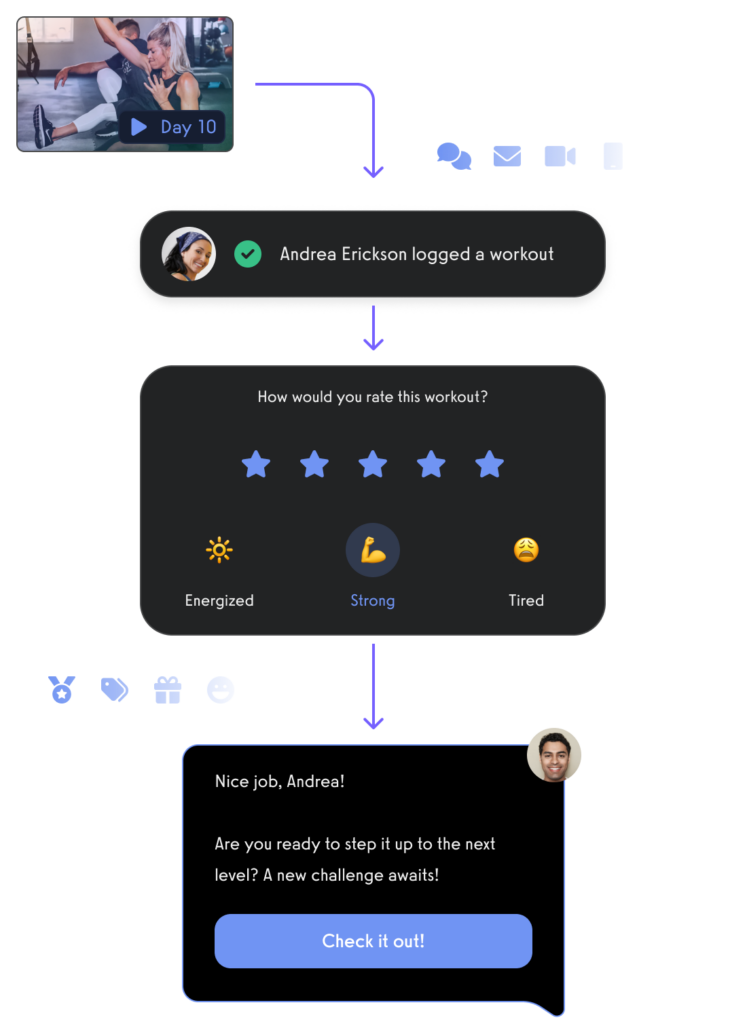
Manage leads with a fitness CRM.

Create and send fitness assessments with ease.
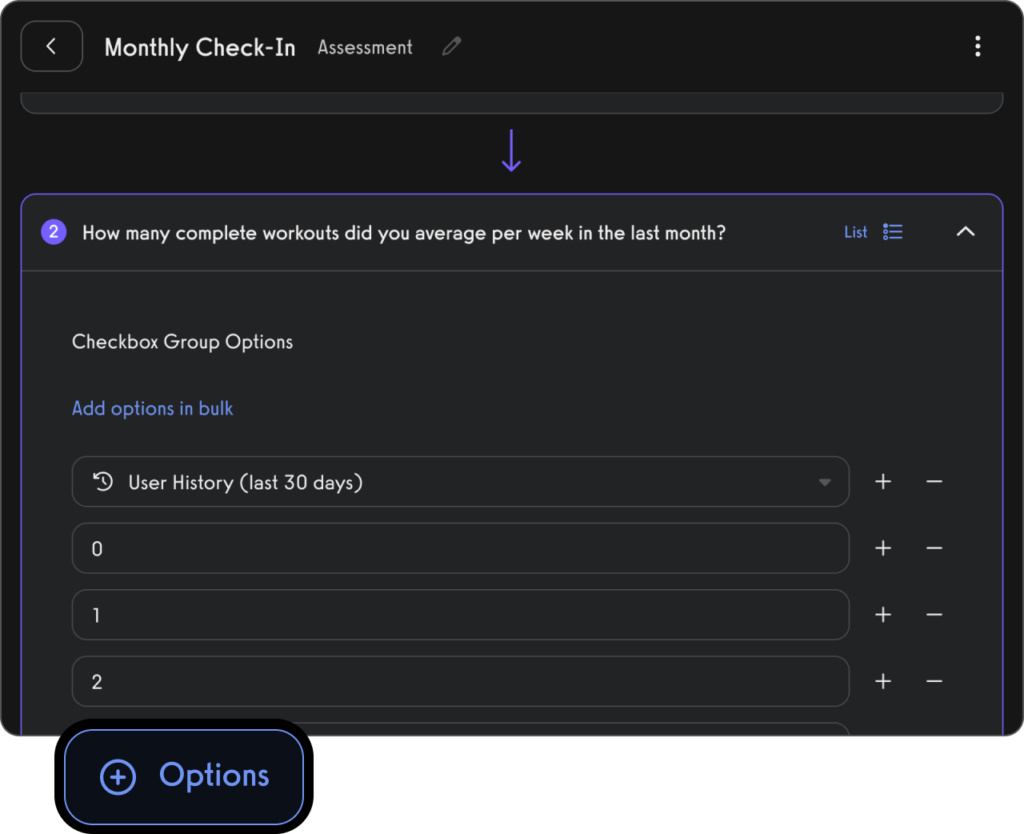
Use fitness habit tracking to inspire and motivate personal training clients (in-person and remote).

Use fitness progress photos to engage with clients.
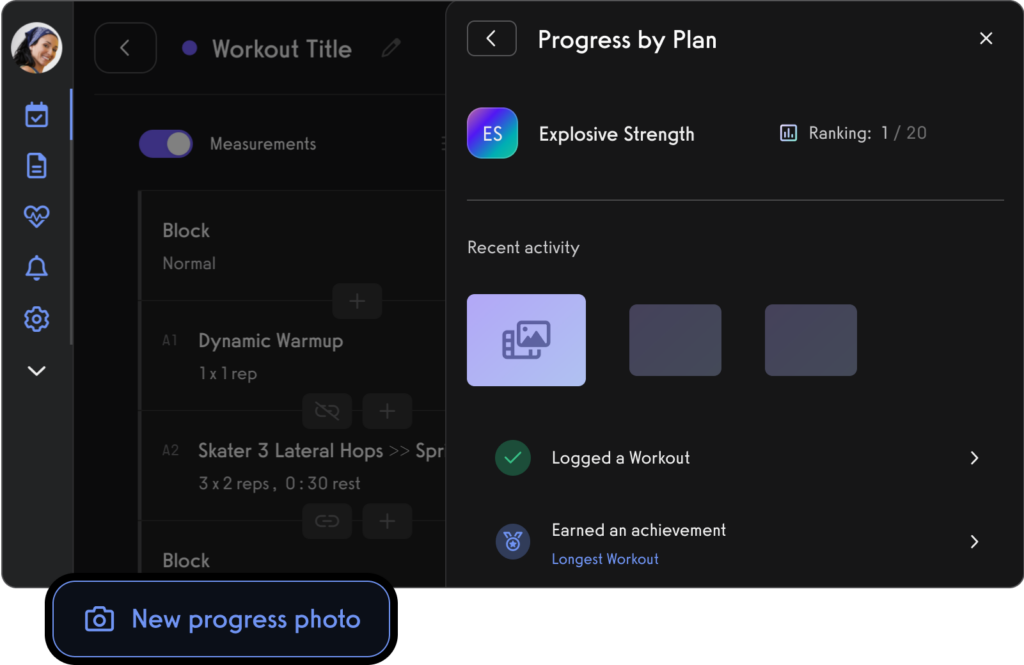
Use fitness leaderboards to track performance and inspire healthy competition.
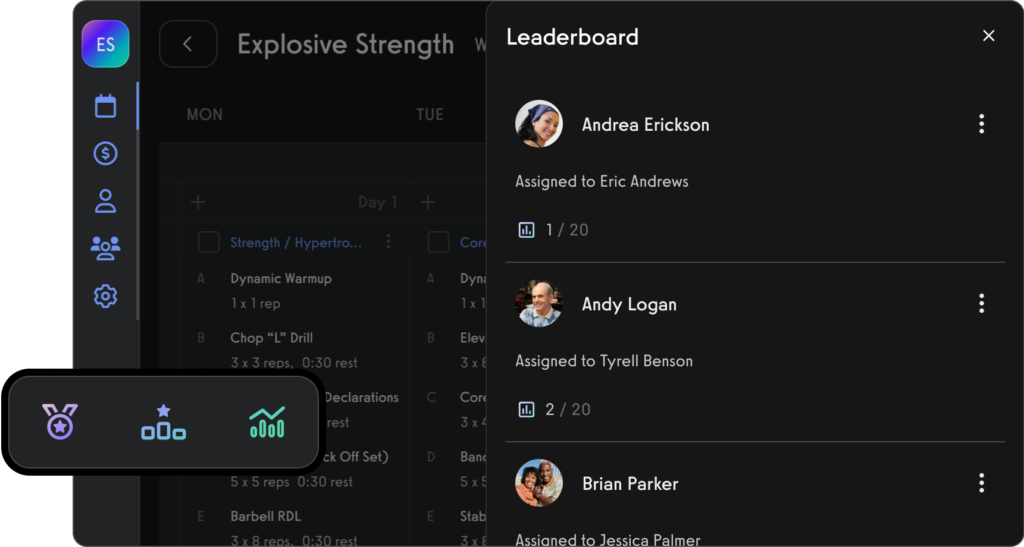
Use the exercise demonstration video library or create your own custom exercise demonstration videos.
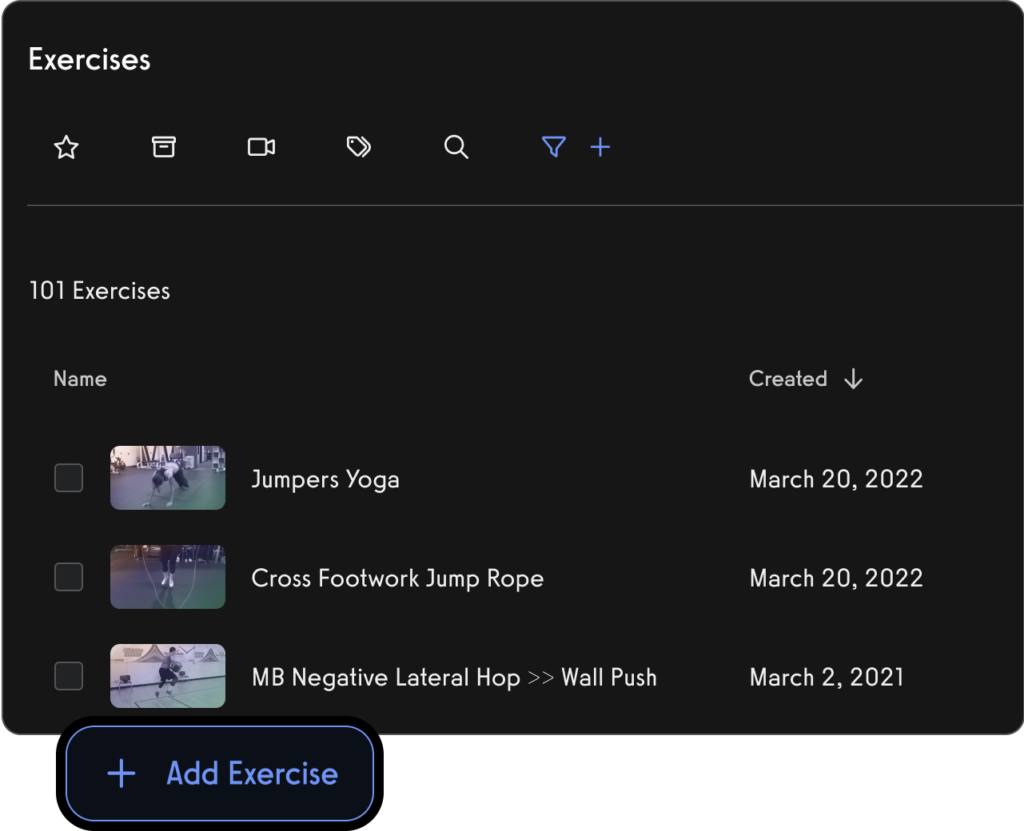
Create workout plans for parents and dependents, teams and more.

Manage personal training clients with ease.

Book appointments for clients (Read More: Best Gym Booking Software)

Create classes and fitness groups

Manage fitness challenges (Read More: 100+ Fitness Challenge Ideas)
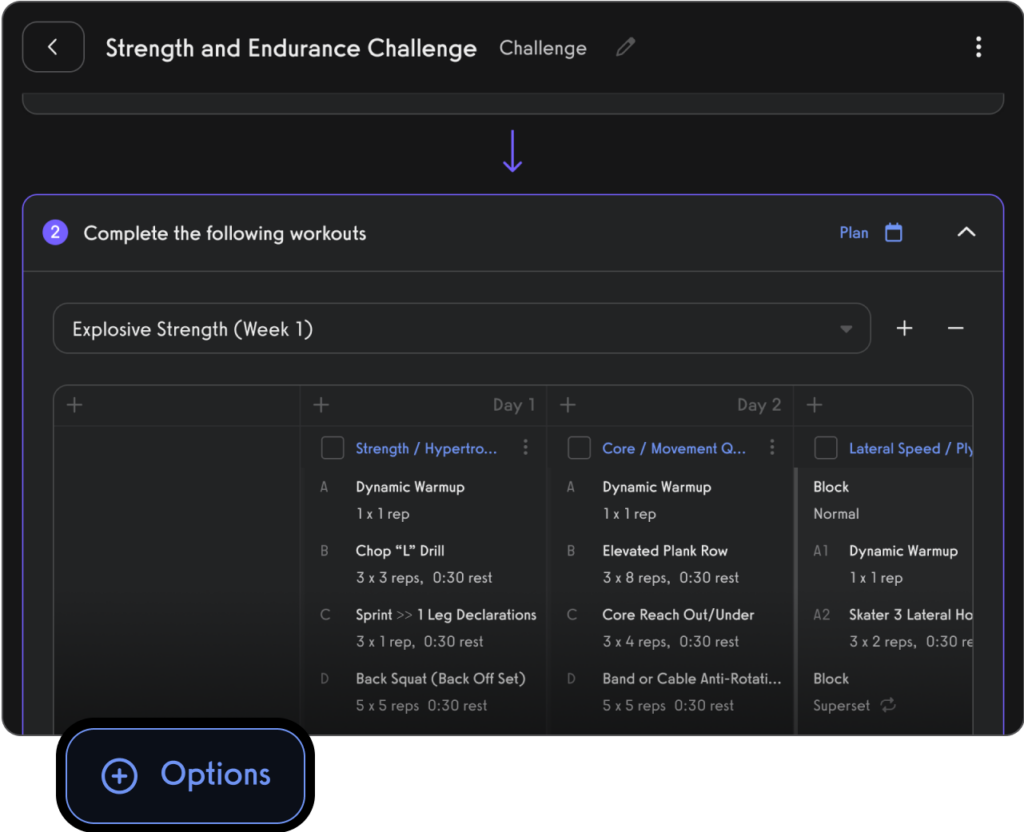
Process payments for open gym, classes, and personal training.

Communicate with gym members, athletes, team members, personal training clients, class members, parents, and dependents via SMS, email, and in-app push notification.
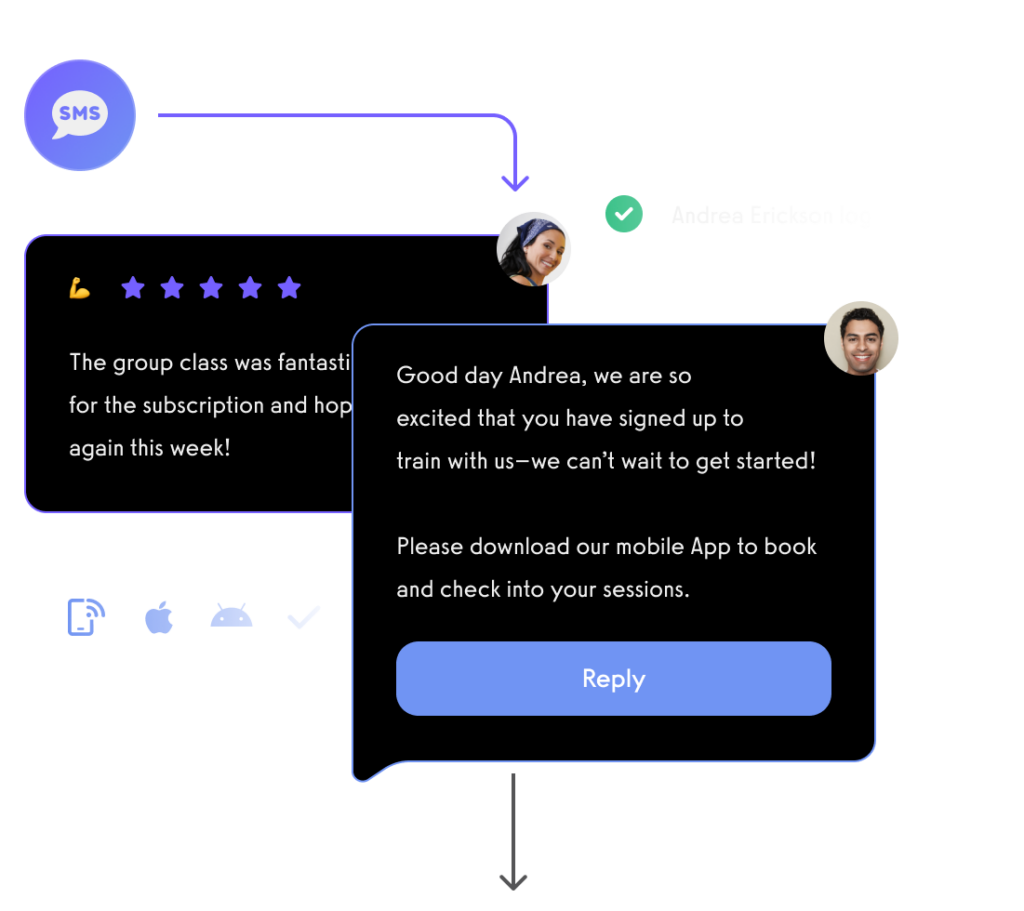
View performance over time, track personal records, and other fitness stats with performance reporting dashboards.

And of course, view all of your fitness business reports easily too.

All from your custom-branded fitness apps (Read More: Best Gym Mobile Fitness Apps Software)

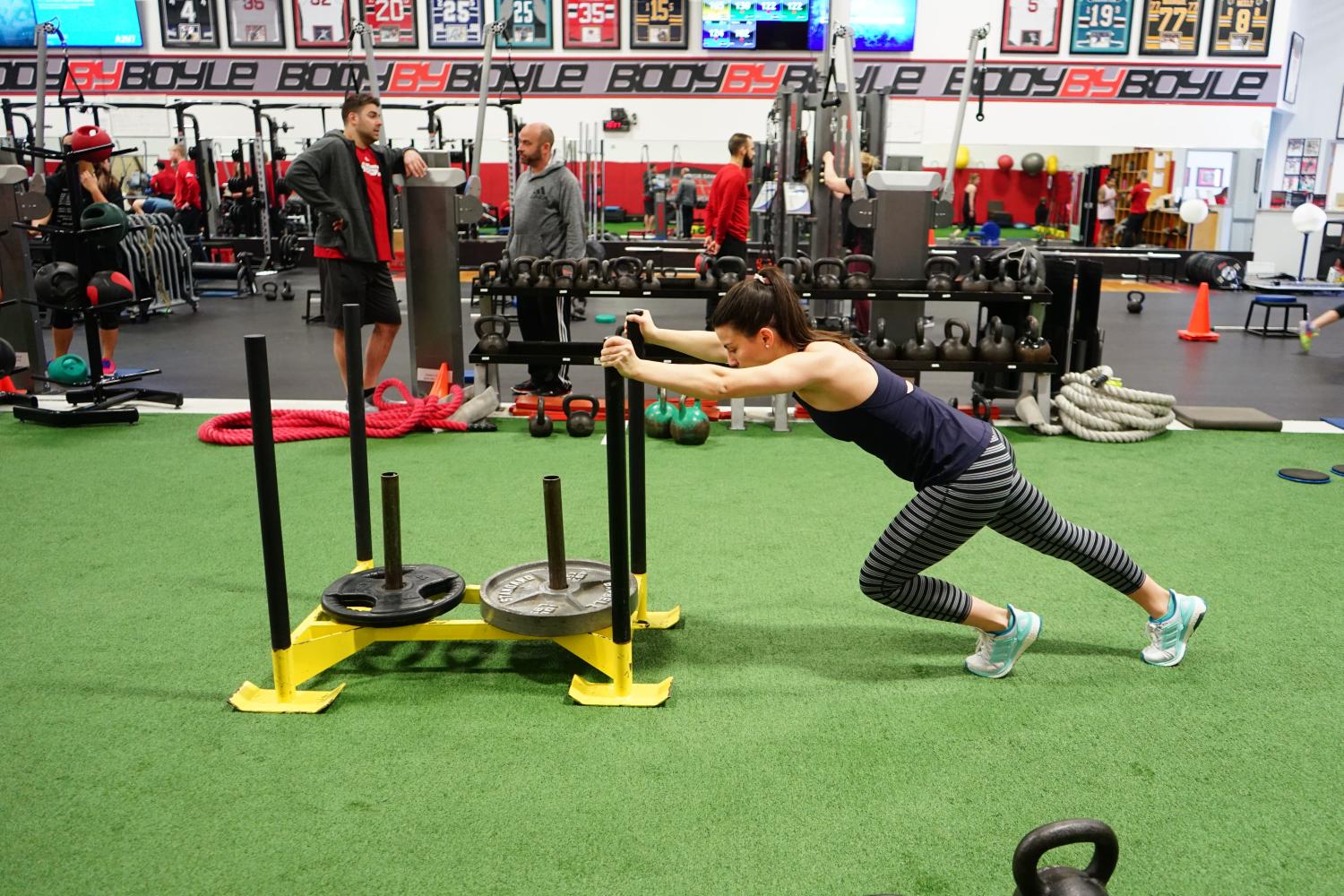
Want to learn how your fitness business can take it to the next level? Get a demo now!
References:









